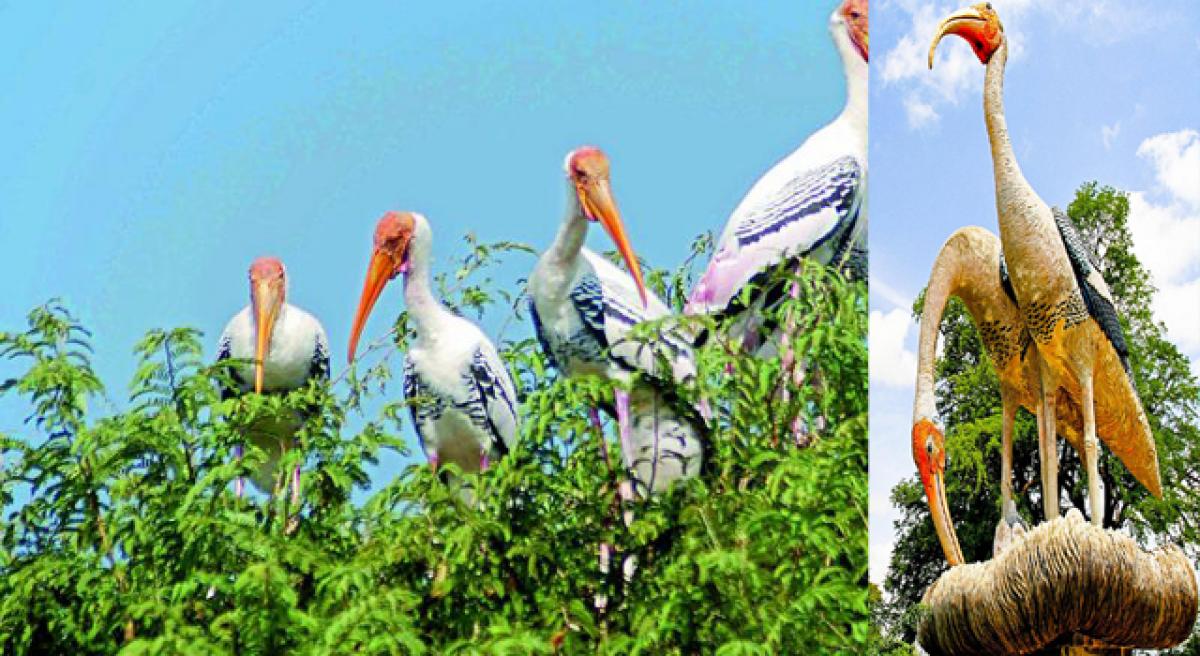Live
- Delhi Police busts gang involved in cable theft on Delhi Metro Blue Line
- MP's Gita recitation programme finds place in Guinness World Records
- Pawan Kalyan Shines Globally as 2nd Most Googled Actor of 2024 Amid Busy Film, Political Career
- Disruptor of House is the chairman himself: Cong and INDIA bloc’s pointed remarks on No-trust notice
- IIIT-Bangalore to host computer vision conference ICVGIP 2024
- F1: Fernando Alonso ‘still dreaming’ of third world championship
- WI vs Bangladesh Watch Controversial Banter Between Shakib and King
- EFLU Celebrates Bharatiya Bhasha Diwas
- Manchu Manoj Submits Bond of Rs. 1 Lakh to Rachakonda Commissioner
- Cuba denounces US 'theft' of Havana Club rum trademark
Just In

Nearly 2,000 painted storks, especially from Siberia in Russia, visit Veerapuram village in Chilamattur mandal, an age-old bird habitat, every year in March beginning for over a century. As the birds have already started arriving to their annual habitat, the forest department had built water trenches and fish feed supply points for these migratory birds.
Chilamattur (Anantapur): Nearly 2,000 painted storks, especially from Siberia in Russia, visit Veerapuram village in Chilamattur mandal, an age-old bird habitat, every year in March beginning for over a century. As the birds have already started arriving to their annual habitat, the forest department had built water trenches and fish feed supply points for these migratory birds.
There are different types of trees in Veerapuram village and hence enough nest building space is available for birds. Apart from the green vegetation, there are many small herbs, shrubs and wild grass all over the village.
Dry branches and twigs of plants scattered on the ground along with sticks from same trees and others can be used for nest building. The nest building material was reused year after year. Both male and female birds were involved in nest building and they take 5-7 days to build a nest.
Although no preference is shown to any plant materiel, some birds choose aromatic plant material for constructing nests, which may have insecticidal properties to repel predators and pieces of snake slough. It was done because these may deter some nest predators. More birds were present at the beginning of the season than the number of nests.
Painted storks are colonial tree nesting birds, nesting on different trees with often 70 to 100 nests per tree, according to Sri Krishnadevaraya University (SKU) Zoology Prof Philip.
Several thousand pairs have been known to nest in rookeries. After arrival in the village, the storks start to build new nests and use the old nests by refurbishing them at different time periods each year. The birds prefer trees which are inside the village where there is human habitation.
They seem to be more secure when villagers are round. The nests were built on any available tree but not on outside the village. The birds seem to enjoy the fellowship of villagers. Prof Philip said that the villagers are very friendly to birds and have made an unwritten law not to do any harm and at the same time protect the Storks from other predators and from outsiders. Storks fly out from 6 am and return from 12 noon onwards in group of 10-22.
The SKU team observed them during their visit to neighbouring Veerapuram, Lakshmipuram, Amanibyrasagara (Gudibanda), Chilamathur, Hussainpuram, Nelakombu, Yellodu, Yarrabelli, Chamarlapalli, Pathachamarlapalli, Dadireddypalli, Maruvakothapalli, Kothasamallapalli tanks and Parugodu dam, birds standing and waiting to catch prey. Fish, purchased from local market were fed to six birds (adult and young ones/2-3 months old) for six days and the amount of fish consumed by each bird on an average was 1.20 kgs.
The painted stork (Mycteria leucocephala) has been a visitor to Veerapuram village, for more than a century. This heronry is quite large with more than 1,000 birds. This could improve if there is enough food available for birds.
Protection of species and conservation of their habitats is the need of the hour by constructing artificial ponds, tanks and planting. We reiterate the need for conservation of foraging grounds and plantation of trees at Veerapuram village. The present concern is about the climate change affecting monsoon as nesting for breeding of painted storks are monsoon dependent.
By Ravi P Benjami

© 2024 Hyderabad Media House Limited/The Hans India. All rights reserved. Powered by hocalwire.com







